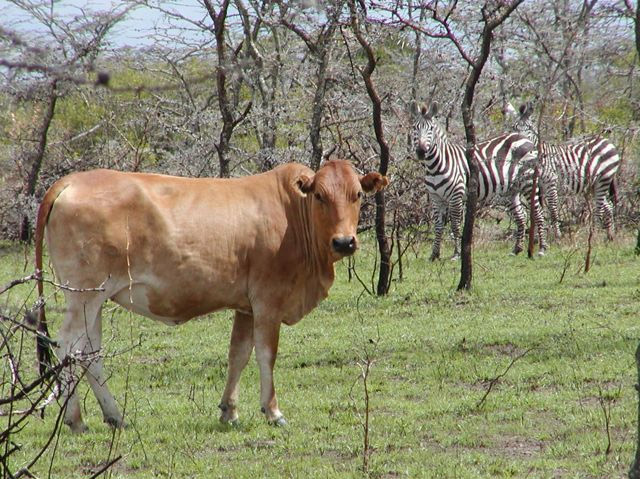Pre-Historic Dairy Cows - Planet Earth Online
Interview with
Cows milk is a remarkable food - not only for drinking, but for cheese and butter, yoghurt and cream. So when did we first decide to use cows as walking larders to fulfil our nutritional needs?
Scientists from the University of Bristol have analysed pots found in, what is now, the Sahara Desert in Libya but - thousands of years ago - was verdant countryside.
By studying chemical residues found in these containers, they've discovered the first direct evidence that people in Africa were using cattle for milk more than 7000 years ago.
Planet Earth podcast presenter, Richard Hollingham, has been talking to archaeological scientist Julie Dunne, at the University's farm in Somerset....
Julie - Well, what we looked at was lipids in ceramics that were excavated from the rock shelter in the region and those lipids tell us that those people were using milk products and also animal fat products and processing them in their pots.
Richard - And they were using this milk for what?
Julie - Well it probably would have been making butter, cheese and yoghurt. We could tell it was processed in the pots and the reason they would have probably processed it is because most humans are... well humans then were lactose intolerant, in other words they couldn't drink milk, they would have been quite ill, they would have had very unpleasant symptoms. If you process milk that reduces a lot of the lactose content and they could have eaten it without becoming ill.
 Richard - These pots were from 7,000 years ago, so pre-history and in that time we've managed to evolve the ability to digest milk?
Richard - These pots were from 7,000 years ago, so pre-history and in that time we've managed to evolve the ability to digest milk?
Julie - Yes, it's quite remarkable. It's a very good example of selection in action. Around about 10,000 years ago when people started dairying and settled down living a farming lifestyle as opposed to being hunter gatherers nobody could tolerate milk. But obviously the new technology comes in and there are these wonderful creatures called cows, they are walking larders and people obviously want a bit of this new technology. They're like an iPad of the ancient world and once you start processing these milk products and using them, within about a thousand years a gene evolves which allows people to tolerate milk so we've become lactose persistent.
Richard - How do you know they were after the milk rather than milk as a by product, that milk was the key to this?
Julie - We can identify whether they were processing either milk or the fats from the animal, the flesh of the animal in the pots. When we did what we call lipid analysis, 50% of the pots showed evidence that milk was processed in them. So it was clearly important to these people. Bear in mind that region, although it had been quite green and wet in the last ten thousand years it was beginning to dry up, and as cattle start to come into the area you are getting these periods of aridity. Cattle are important because they're a source of liquid on the hoof as it were, so these people were moving around the landscape with their cattle and if there wasn't any water they would be able to get a drink from the cattle.
Richard - So the cattle became much more valuable for producing milk than they did for meat or by products like skins or whatever?
Julie - Yes, we think so, we think so. We think it's what we call the secondary products of the animal, the milk, the cheese, the butter, the yoghurts; those are the things that were much more important to ancient people rather than the actual flesh of the animal. Why would you kill something that is going to give you food every day?
Richard - What sort of difference did this make to humans and human civilisation?
Julie - The transition from becoming hunted gatherers to settling down - it enabled the development of much bigger communities and so on which eventually led to the establishment of things like city states and so on and so on and finally to where we are today.
Richard - So this was happening in Africa - how did we end up here farming cows, drinking milk, making cheese, all this stuff?
Julie - Yeah, we really do so a kind of different pattern emerging in Europe, so cattle were actually domesticated in Europe, we think, and they moved into Africa but they also moved with people the other way and spread out right across Europe and into Britain and Ireland finally getting here round about 4,000 BC, so six thousand years ago. Pretty much across Europe people settled down, they became farmers and they started using milk and its products.
Richard - So cattle turn out to be incredibly important for these prehistoric people and for the development of humans, and they're still important today?
Julie - Absolutely, yes. These cattle were incredibly important to these ancient humans. For a start they created the most remarkable rock art which shows how much they clearly thought about and relied on their animals. They were clearly just as important then as they are today.









Comments
Add a comment